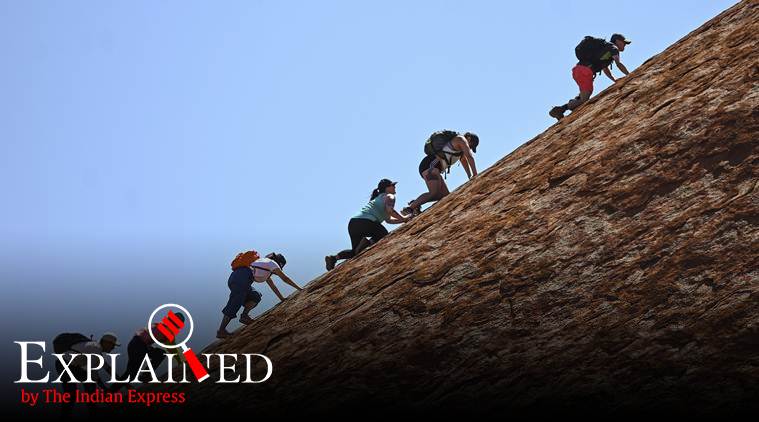- India
- International
Explained: What is Uluru, Australia’s famous desert rock, and why can’t you climb it any more?
Uluru, one of Australia's most famous tourist attractions, is considered sacred by the indigenous Anangu people.
 Tourists climb the sandstone monolith called Uluru on October 25, the last day climbing was allowed. (Lukas Coch/AAP Image via AP)
Tourists climb the sandstone monolith called Uluru on October 25, the last day climbing was allowed. (Lukas Coch/AAP Image via AP)
On October 25, Friday, a last line of climbers scaled Uluru, Australia’s famous desert rock. From October 26, climbing the rock, considered sacred by the local Anangu people, has been banned.
While many have welcomed the move as a recognition of the rights of Australia’s indigenous people and of the importance of their cultures and beliefs, others have protested, claiming Australia belongs to “all its people”, and the religious beliefs of a few should not interfere with an activity popular worldwide.
Explained: What is Uluru?
Uluru is an ancient sandstone monolith in Central Australia, famous for its gorgeous auburn hue, which seems to change with changing seasons and time of day. It is one of Australia’s prime tourist attractions.
The rock has a circumference of 9.4 km, and its 1,140-foot summit — taller than Eiffel Tower — has been a popular climbing destination.
Uluru is considered sacred by Australia’s indigenous Anangu people. According to the Uluru-Kata Tjuta National Park website: “The Central Australian landscape (of which Uluru and Kata Tjuta are an important part) is believed to have been created at the beginning of time by ancestral beings. Uluru and Kata Tjuta provide physical evidence of feats performed during the creation period…Anangu believe they are the direct descendants of these beings and are responsible for the protection and appropriate management of these ancestral lands.”

For the Anangu, every crack, crevice, cave on Uluru bears witness to stories they consider sacred — some so sacred they can’t be shared with outsiders.
What is the controversy over climbing Uluru?
The changes in Australia’s attitude towards Uluru are demonstrative of how the rights and beliefs of indigenous people, long sidelined by colonisers, have made a very slow but steady entry to the mainstream.
The day from which the climbing ban has come into force — October 26 — marks the 34th anniversary of Australia’s federal government handing over to the Anangu the land title of the national park in which Uluru stands.
The Anangu, the traditional owners of the land, gave the park back to the government on a 99-year lease, and it is now run by a board that has a majority of Anangu members.
Even the name of the rock has undergone changes with the changing attitudes.
While the local people have called it Uluru for thousands of years, in 1873, British-born explorer William Gosse “discovered” it and named it Ayers Rock, after the then-premier of the British colony of South Australia, Sir Henry Ayers.
It was called Ayers Rock for more than a 100 years, till in 1993, it was renamed “Ayers Rock/Uluru”. This order of naming was reversed on November 6, 2002.
The Anangu have long advocated a climbing ban on the rock. Around the rock, there are signboards requesting tourists to not go atop it. However, the ban was formally announced only in 2017.
A two-year transition period was allowed for so that other tourist attractions, especially those explaining its significance, could be built at the rock.
One of the slogans opposing the climbing ban has been “Äyers for all”, in an apparent attempt to distance the Anangu from the ownership of the rock.
How many people climb Uluru?
The number of those climbing the Uluru fell considerably since the 1970s to the 2000s. According to the most recent data available, 300,000 people visited Uluru in 2015, of whom only 16.2% climbed the rock.
However, the number of climbers rose after the ban was announced in 2017. While some see it as tourists’ wish to tick off an activity before it is banned, others saw it as backlash to the traditionally disadvantaged seeking to reclaim their place in a country’s narrative.
However, not all tourists oppose the climbing ban. Local officials say a lot of visitors have become more sensitive to the sentiments of the indigenous people. Some who had climbed Uluru in the past have sent back memorabilia they collected, as “sorry rocks”.
Is there something like an Uluru in India?
Not exactly, but in India too, climbing certain mountain peaks is not allowed, because they are considered sacred by locals.
In August this year, the Centre had lifted an 18-year-old ban on scaling the Kanchenjunga, which people in Sikkim hold sacred. After protests, the Indian Mountaineering Foundation said it would not issue permissions to tourists to climb Kanchenjunga and other sacred peaks.
Don’t miss from Explained: Why TikTok is under the scanner in US
More Explained
EXPRESS OPINION
May 03: Latest News
- 01
- 02
- 03
- 04
- 05







































